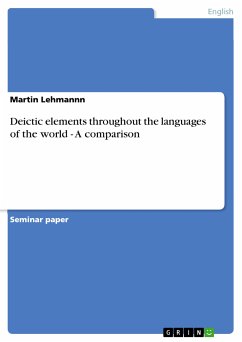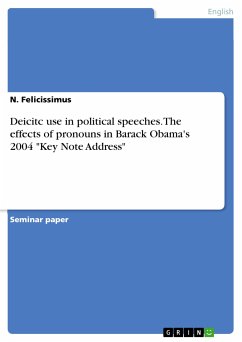Seminar paper from the year 2003 in the subject English Language and Literature Studies - Linguistics, grade: 1,0 (A), Free University of Berlin (Institute for English Philology), course: Lexical Semantics, language: English, abstract: [...] Who are the speaker and the addressee? When and where did the utterance take place? The tokens "I", "you", "next week" and "here" are deictic expressions. According to Charles J. Fillmore (FILLMORE 1997: §1) "[d]eixis can be defined as the anchorage of an utterance in the extralinguistic context." Anderson¿s and Keenan¿s definition (1985) is similar to Fillmore¿s: "Following standard usage, we consider as deictic expressions (or deictics for short) those linguistic elements whose interpretation in simple sentences makes essential reference to properties of the extralinguistic context of the utterance in which they occur."1 (ANDERSON and KEENAN 1985: 259) The "most frequently quoted definition" (LENZ 2003: VII) of deixis comes from John Lyons (1977): "By deixis is meant the location and identification of persons, objects, events, processes and activities being talked about, or referred to, in relation to the spatiotemporal context created and sustained by the act of utterance and the participation in it, typically, of a single speaker and at least one addressee." (Lyons 1977: 637) The definitions show that deixis does not merely belong to the field of semantics. The use of deictic elements depends on a particular context. Thus, deixis is on the interface of semantics and pragmatics. Since deixis is a universal phenomenon, typologists examine its variations and similarities throughout the languages of the world. The initial example shows that we rely heavily on deictic elements in every-day language. We refer to places, objects, persons, times, and many more things by means of deixis. Therefore, the study of deixis is not only interesting to linguists but to anyone who is engaged in language in general. My approach is to use deictic elements in English as a starting point. I will then move on to compare the strategies of English with those of other languages. My aims are to show how wide the range of deictic elements in human language is and how much the concepts of certain languages vary from what we are used to. There are different types of deixis: The main categories are local deixis, person deixis, social deixis, furthermore time deixis and manner deixis. This paper concentrates on local deixis, "the prototype of deixis" (SENNHOLZ 1985: 168-169). Additionally, a general overview on person and social deixis is provived.
Dieser Download kann aus rechtlichen Gründen nur mit Rechnungsadresse in A, B, BG, CY, CZ, D, DK, EW, E, FIN, F, GR, HR, H, IRL, I, LT, L, LR, M, NL, PL, P, R, S, SLO, SK ausgeliefert werden.









